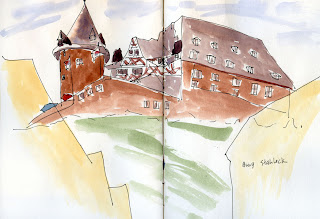 |
| 7/31/13 Platinum Carbon ink, watercolor, Stillman & Birn Beta sketchbook |
Whenever I visit farmers markets with a sketchbook (OK, I
admit, I never visit farmers markets without a sketchbook), I usually head for
buskers and other musicians to sketch. But today I wanted to sketch more of the
market itself to contribute to the Urban Sketchers Flickr weekly theme thread, “Markets,” so I decided to take a wider view at Wallingford Farmers Market. I knew I wanted to capture the rows of tents and colorful
produce, but I was having difficulty finding a compelling composition. On top
of that, the flat, dark gray sky was keeping all the shadows away, which was
also frustrating.
As I pondered all of this, I heard a voice repeatedly saying, “Copy? Have a nice day,” so I looked for its source. The voice belonged to a Real Change newspaper vendor hawking this week’s issue of Seattle’s advocacy publication for homeless and low-income people. A-ha! He was exactly what my composition needed.
When I bought a copy of the paper from him and showed him the sketch, Yemane Berhe, originally from West Africa, asked me to e-mail the sketch to him in care of the newspaper.
Shopping for organic corn, peaches and blueberries, I noticed the sky growing even flatter and darker. Thunder rumbled deeply in the distance. I made it home with the top down before the drops began to fall.







































